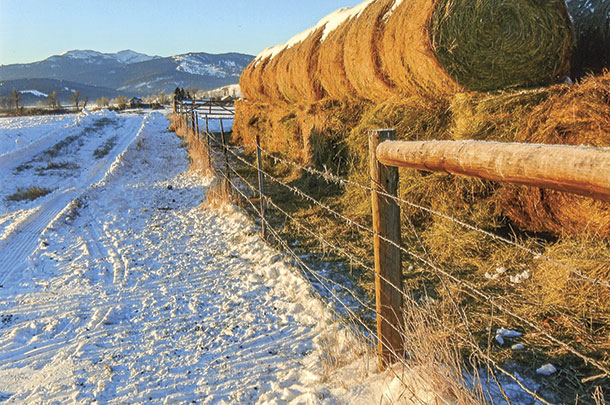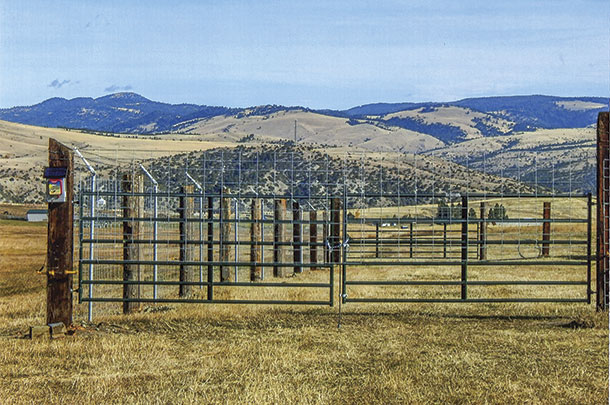These ranchers are constantly defending both their summer crops and their winter haystacks from several elk herds ranging from 175 to over 1,000 head that linger in the area year-round.
Harry Allen, who runs about 100 cow-calf pairs on 1,100 acres near Gold Creek, Montana, struggles with the numerous elk that have, over the past 10 years, made the area surrounding Gold Creek their home. Allen, who has ranched in the Gold Creek area for 18 years, says the elk activity has intensified over the past 10 years to a barely manageable level.
He credits the increased disturbance from elk to the reintroduction of wolves in the area. “We have a generational effect that has taken place,” Allen says. “The elk have moved down into the meadows and the hay land, and they have given birth to their calves, and the calves are born and raised here so they don’t really know better than not to go back up into the hills. Of course that’s not 100 percent, but by and large, that’s what we feel has happened.”
Allen says there are two herds of roughly 175 and 250 elk, respectively, he sees most often. “They’ve developed a corridor in which they travel, like a migration route,” he says. “They are migrating from one grazing ground to the other, and I seem to be right in the middle of that corridor.”
Allen guesses the local elk herds bother at least 20 operations in a roughly 20-square-mile area. “That is not etched in stone, though,” he says. “I could go 20 miles from here and say, ‘Is there an elk problem?’ and get the answer, in my best guess, of ‘Oh yeah, there is.’”
Winter damage
Allen’s biggest struggle with the elk is keeping them out of his haystacks during the winter. While the intensity of the pressure on his haystacks varies depending on how severe the winter is, the elk are always there.
He says the damage the elk do is more than just the hay they consume; it’s the damage they do to the rest of the stack they don’t eat that can be even more serious. “They come in, and they’ll stand on the stack, and they’ll eat off the sides of it,” he says. “They don’t just pick out one bale or 10 bales; they start nibbling wherever their nose leads them.”

The decimated bales make the rest of the stack unstable and more risky to handle. The broken and half-eaten bales also take more time and labor to feed out, time that becomes precious on a ranch where the work is never fully finished.
Allen says out of the roughly 1,000 round bales he puts up each year, maybe 50 of those bales – volume-wise – will be lost due to elk depravations. “It isn’t just one bale that disappears, and then they go get another one,” he says. “That would be a nice way to measure things.”
Best defense: Fence
Allen started out with an electric fence outside a barbed wire fence around his haystacks, which did not prove to be very effective since the high snows in the winter made the electricity short out.
Allen went to the Montana Fish, Wildlife and Parks agency for advice and resources, and soon began building a permanent stackyard. “They made suggestions on the materials, but they were more focused on the type of fence,” he says.
They planted railroad ties 8 feet apart and used chain-link posts between them, and used wire mesh livestock panels to build the fence up to 6 feet tall. Allen then attached barbed wire arms facing outward to the tops of the chain-link posts, finishing off the fence at 7 feet tall.

Allen finished building the first stackyard in the fall of 2017. Allen says one of the ideas behind the permanent stackyard was: It would last a long time and only require periodic maintenance. He says it has survived its first winter in fine style. “It’s been what I would call ideal,” he says. He plans to build more stackyards in the future as time and resources allow.
Summer/fall damage
Allen’s neighbor, John Hollenback, runs about 300 head on 3,300 acres and ranches on the same Gold Creek area where he was raised. He keeps a little over 200 acres under production in alfalfa and about 3,000 acres of grazing ground. He has also experimented with cover crops.
Hollenback says he struggles with elk more during the fall than other times of the year. He says he has counted as many as 680 head leaving his hay fields around daylight. “They can do quite a bit of damage,” he says. “I lose a lot of my second crop to them.
Early in the fall is when I’ve taken a hit with grazing. We have lost major feed around that time.” He also tried planting cover crops one year, but the elk came in and did considerable damage to those crops as well.
He also says the elk are used enough to human presence they will come up by his house at night. “By September, they come within 5 feet of the house, bugling in the middle of the night, but once daylight comes, they’re gone,” he says.
Hollenback has problems with elk in the spring as well. “Where we’ve grazed the year before, they come in the spring of the year when the grass is coming up, and they eat that down,” he says. “So later, you don’t have places to go with your cattle to graze because they eat it down, and then it gets dry and you don’t get a lot of production out of it. That’s a major problem in our part of the country.”
Hollenback says the loss from grazing might seem insignificant year by year but, added up over time, amounts to a very significant loss. “I’ve put some figures to it over the last five years, and with the loss of my cover crops and the loss of my alfalfa, just on my small place, I’ve lost at least $100,000 worth of feed over the last five years,” he says. “[The elk] are just out of control, really.”
Search for a long-term solution
The Montana Fish, Wildlife and Parks agency has been working to help ranchers combat the elk problem by extending the hunting season. Efforts by Progressive Cattleman to reach the agency were not successful.
“Our elk hunting season for cows here runs from Aug. 15 to Feb. 15,” Allen says. “That’s a six-month season, and you can buy an additional tag besides the regular season tag as long as one is for a cow.”
Hollenback says hunting is a good idea, but several out-of-state ranch owners do not allow hunting on their property. “They don’t understand our problem, so they close their places to hunting, and the elk go there and we can’t get to them; we can’t do any hunting,” he says. “I don’t know how we’re going to solve that problem, but we’re going to have to do something.”
Both ranchers say the local government agencies have been helping all they can but face their own obstacles. “Fish, Parks and Wildlife are caught in the middle,” Allen says. “Ranchers have problems, and they want to find somebody to gripe to and, of course, they have to consider everybody except God in their decision-making.”
Hollenback says hunting helps but cannot be the only solution to the problem, since the elk population and the problem grows every year. He says more needs to happen before the problem can be controlled. “There are a lot of good people trying to help us, but their hands are tied too with all of their regulations.”
“The elk is a beautiful animal,” says Allen, “but there gets to be a time when enough is enough already.” ![]()
PHOTO 1: Harry Allen says the elk will come right onto his feeding ground and eat alongside the cattle.
PHOTO 2: A conventional fence is an ineffective deterrent to elk.
PHOTO 3: A completed permanent stackyard fence. Photos provided by Harry Allen.

-
Carrie Veselka
- Associate Editor
- Progressive Cattleman
- Email Carrie Veselka








